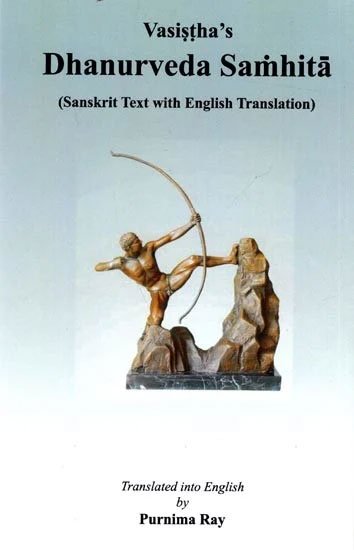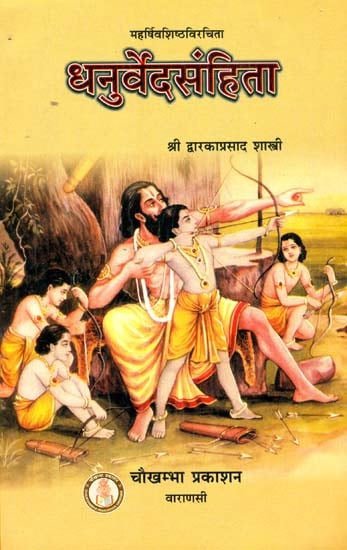Dhanurveda Samhita [sanskrit]
3,015 words
The Sanskrit text of the Dhanurveda-samhita attributed to Vasishtha. Dhanur Veda is a type of ancient India science whose roots date to the 2nd millenium BCE. It is counted among the Upavedas literature. This specific version of the Dhanurveda contains roughly 240 sections of Sanskrit text.
Verse 1.20
शिखास्थाने न्यसेदीशं बाहुयुग्मे च केशवम् ।
ब्रह्माणं नाभिमध्ये तु जङ्घयोश्च गणाधिपम् ॥ २० ॥
śikhāsthāne nyasedīśaṃ bāhuyugme ca keśavam |
brahmāṇaṃ nābhimadhye tu jaṅghayośca gaṇādhipam || 20 ||
Note! The following is not a translation of the above verse, but merely an arbitrary extract of the English text.
Place Lord Shiva on the head and Lord Keshava on the pair of arms. Brahma is the lord of the hosts in the middle of his navel and on his thighs.
English translation by Hardayalu Swami (2001) Buy now!
Glossary of Sanskrit terms
Note: This extracts Sanskrit terms and links to English definitions from the glossary, based on an experimental segmentation of verse (1.20). Some terms could be superfluous while some might not be mentioned. Click on the word to show English definitions.
Shikhasthana, Asi, Isha, Ish, Bahuyugma, Keshava, Brahma, Brahman, Nabhimadhya, Jangha, Ganadhipa,
Analysis of Sanskrit grammar
Note: this is an experimental feature and only shows the first possible analysis of the Sanskrit text (Verse 1.20). If the system was successful in segmenting the sentence, you will see of which words it is made up of, generally consisting of Nouns, Pronouns, Verbs, Participles and Indeclinables. Click on the link to show all possible derivations of the word.
- Line 1: “śikhāsthāne nyasedīśaṃ bāhuyugme ca keśavam ”
- śikhāsthāne -
-
śikhāsthāna (noun, masculine)[locative single]śikhāsthāna (noun, neuter)[nominative dual], [vocative dual], [accusative dual], [locative single]
- nya -
-
ni (noun, masculine)[compound], [adverb], [nominative dual], [vocative dual], [accusative dual]ni (noun, neuter)[compound], [adverb], [nominative single], [vocative single], [accusative single]ni (noun, feminine)[compound], [adverb], [nominative dual], [vocative dual], [accusative dual]nī (noun, masculine)[compound], [adverb]nī (noun, neuter)[compound], [adverb], [nominative single], [vocative single], [accusative single]nī (noun, feminine)[compound], [adverb]
- ase -
-
asi (noun, feminine)[vocative single]asi (noun, masculine)[vocative single]
- dī -
-
dī (noun, feminine)[compound], [adverb]dā (noun, masculine)[locative single]
- īśam -
-
īśa (noun, masculine)[adverb], [accusative single]īśa (noun, neuter)[adverb], [nominative single], [accusative single]īśā (noun, feminine)[adverb]īś (noun, masculine)[accusative single]
- bāhuyugme -
-
bāhuyugma (noun, masculine)[locative single]bāhuyugma (noun, neuter)[nominative dual], [vocative dual], [accusative dual], [locative single]
- ca -
-
ca (indeclinable conjunction)[indeclinable conjunction]ca (noun, masculine)[compound], [vocative single]ca (noun, neuter)[compound], [vocative single]
- keśavam -
-
keśava (noun, masculine)[adverb], [accusative single]keśava (noun, neuter)[adverb], [nominative single], [accusative single]keśavā (noun, feminine)[adverb]
- Line 2: “brahmāṇaṃ nābhimadhye tu jaṅghayośca gaṇādhipam ”
- brahmā -
-
brahma (noun, masculine)[compound], [vocative single]brahma (noun, neuter)[compound], [vocative single]brahman (noun, neuter)[compound], [adverb], [nominative single], [vocative single], [accusative single]brahmā (noun, feminine)[nominative single]√brahm (verb class 1)[imperative active second single]
- āṇam -
-
√aṇ (verb class 1)[imperfect active first single]
- nābhimadhye -
-
nābhimadhya (noun, masculine)[locative single]nābhimadhya (noun, neuter)[nominative dual], [vocative dual], [accusative dual], [locative single]
- tu -
-
tu (indeclinable particle)[indeclinable particle]
- jaṅghayoś -
-
jaṅgha (noun, masculine)[genitive dual], [locative dual]jaṅghā (noun, feminine)[genitive dual], [locative dual]
- ca -
-
ca (indeclinable conjunction)[indeclinable conjunction]ca (noun, masculine)[compound], [vocative single]ca (noun, neuter)[compound], [vocative single]
- gaṇādhipam -
-
gaṇādhipa (noun, masculine)[adverb], [accusative single]
Other editions:
Also see the following editions of the Sanskrit text or (alternative) English translations of the Verse 1.20
Dhanurveda Samhita (धनुर्वेदसंहिता)
by Hardayalu Swami (2001)
Publisher: Khemraj Shrikrishnadass
Buy now!
Vasistha’s Dhanurveda Samhita
by Purnima Ray (2023)
Publisher: Khemraj Shrikrishnadas; ISBN-10: 818670289X; ISBN-13: 9788186702895; 88 pages including 18 illustrations;
Buy now!
Dhanurveda Samhita (धनुर्वेदसंहिता) (संस्कृत एवं हिंदी अनुवाद)
by Shri Dwarka Prasad Shastri (2007)
Title: Dhanurveda Sanhita (Hindi translation); Publisher: Chaukhambha Prakashan, Varanasi; 84 pages including 11 illustrations; Author: महर्षि वशिष्ठ (Maharshi Vashistha); Foreword by Dr. Chakradhar Bijalwan.
Buy now!![Dhanurveda Samhita [sanskrit] - book cover](/uploads/a/Dhanurveda-Sanskrit.jpg)

